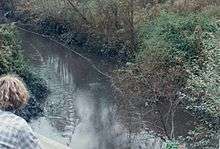Martin County coal slurry spill


The Martin County coal slurry spill was an accident that occurred after midnight on October 11, 2000 when the bottom of a coal slurry impoundment owned by Massey Energy in Martin County, Kentucky broke into an abandoned underground mine below.[1] The slurry came out of the mine openings, sending an estimated 306,000,000 US gallons (1.16×109 l; 255,000,000 imp gal) of slurry down two tributaries of the Tug Fork River. By morning, Wolf Creek was oozing with the black waste; on Coldwater Fork, a 10-foot (3.0 m) wide stream became a 100-yard (91 m) expanse of thick slurry.
The spill, which contained arsenic and mercury, killed everything in the water.[2] It was over five feet deep in places and covered nearby residents' yards. The spill polluted hundreds of miles (300–500 km) of the Big Sandy River and its tributaries and the Ohio River. The water supply for over 27,000 residents was contaminated, and all aquatic life in Coldwater Fork and Wolf Creek was killed. The spill was 30 times larger than the Exxon Valdez oil spill (12 million US gallons (45,000 m3)) and one of the worst environmental disasters ever in the southeastern United States, according to the United States Environmental Protection Agency.[3] The spill was exceeded in volume by the Kingston Fossil Plant coal fly ash slurry spill in 2008.
Furtiveness surrounding disaster
U.S. Secretary of Labor Elaine Chao, wife of Sen. Mitch McConnell (R-Ky.), oversaw the Mine Safety and Health Administration (MSHA) at the time. In 2002, a federal penalty of $5,600 was levied against Massey Energy, and was subsequently paid.[4] When the Bush Administration came into power, they cut the investigation short, as Massey Energy was a generous contributor to the Republican Party.[5][6] In addition, the Bush presidency aimed to expand energy production and resources in the US, and therefore relaxed regulations.[7][8]
Whistleblowing
Jack Spadaro, a whistleblower who worked in natural resources and mining, was one of the lead investigators that looked into the spill. He reported evidence that showed the administration and the engineers who were to be looking out for the best interests of people were aware of another spill in the same area from 1994 on, but they had never released the information to the public and had instead covered it up.[9]
Specifically, Spadaro argued that the Bush administration was covering up the Martin County spill. Spadaro complained that the new administration had given lucrative contracts for work at the academy to friends, and that the MSHA was divided into 186 smaller contracts. The MSHA denied the accusations.
On June 4, 2003 government agents began sifting through Spadaro's documents in his office. He was locked out and placed on involuntary administrative leave. Eventually the investigation was closed and Spadaro's evidence was discarded.
References in popular culture
In 2005 Appalshop filmmaker Robert Salyer released a documentary entitled Sludge, chronicling the continuing story of the Martin County disaster, the resulting federal investigation, and the looming threat of coal slurry ponds throughout the coalfield region. In the wake of the Kingston Fossil Plant coal fly ash slurry spill, Appalshop provided a web stream of Sludge for a limited time.[10]
See also
References
- ↑ Sealey, Geraldine (October 23, 2000). "Sludge Spill Pollutes Ky., W. Va. Waters". ABC News. Retrieved 2014-06-06.
- ↑ https://www.cbsnews.com/news/a-toxic-cover-up/
- ↑ Sludge: a documentary by Robert Salyer Archived 2013-01-07 at the Wayback Machine. Retrieved 2014-06-06.
- ↑ Retrieved 2018-02-01.
- ↑ https://www.cbsnews.com/news/a-toxic-cover-up/
- ↑ "Before the Blankenship-McConnell Feud, the Senator Aided the Mining Executive — ProPublica". ProPublica. Alec MacGillis. 2018-05-07. Retrieved 2018-05-07.
- ↑ "Energy for America's Future". georgewbush-whitehouse.archives.gov. Retrieved 2018-07-30.
- ↑ Scott, Shaunna L.; McSpirit, Stephanie M. (2017). "The Martin County Coal-Waste Spill: Reflections and Suggestions". In Lee, Brian D. Water in Kentucky: Natural History, Communities, and Conservation. University Press of Kentucky. pp. 73–80. ISBN 978-0-8131-6870-8.
- ↑ BRYANT, ANNIE; JAMISON, PHIL; JENKINS, CARL; PEPPER, SUSAN; WEINSTEIN, LEILA; BEAVER, PATRICIA D.; Spadaro, Jack (2007). "Interview with Jack Spadaro: On Being a Whistleblower for Mine Safety and Health". Appalachian Journal. 34 (3/4): 326–350.
- ↑ "Archived copy". Archived from the original on 2009-01-06. Retrieved 2008-12-31.
External links
- Sludge slinging - article about mining engineer Jack Spadaro who has dedicated his life to preventing coal sludge spills
- A Toxic Cover-Up? - article about Jack Spadaro and the Martin County sludge spill.
- Internal Review of MSHA's Actions At the Big Branch Refuse Impoundment.